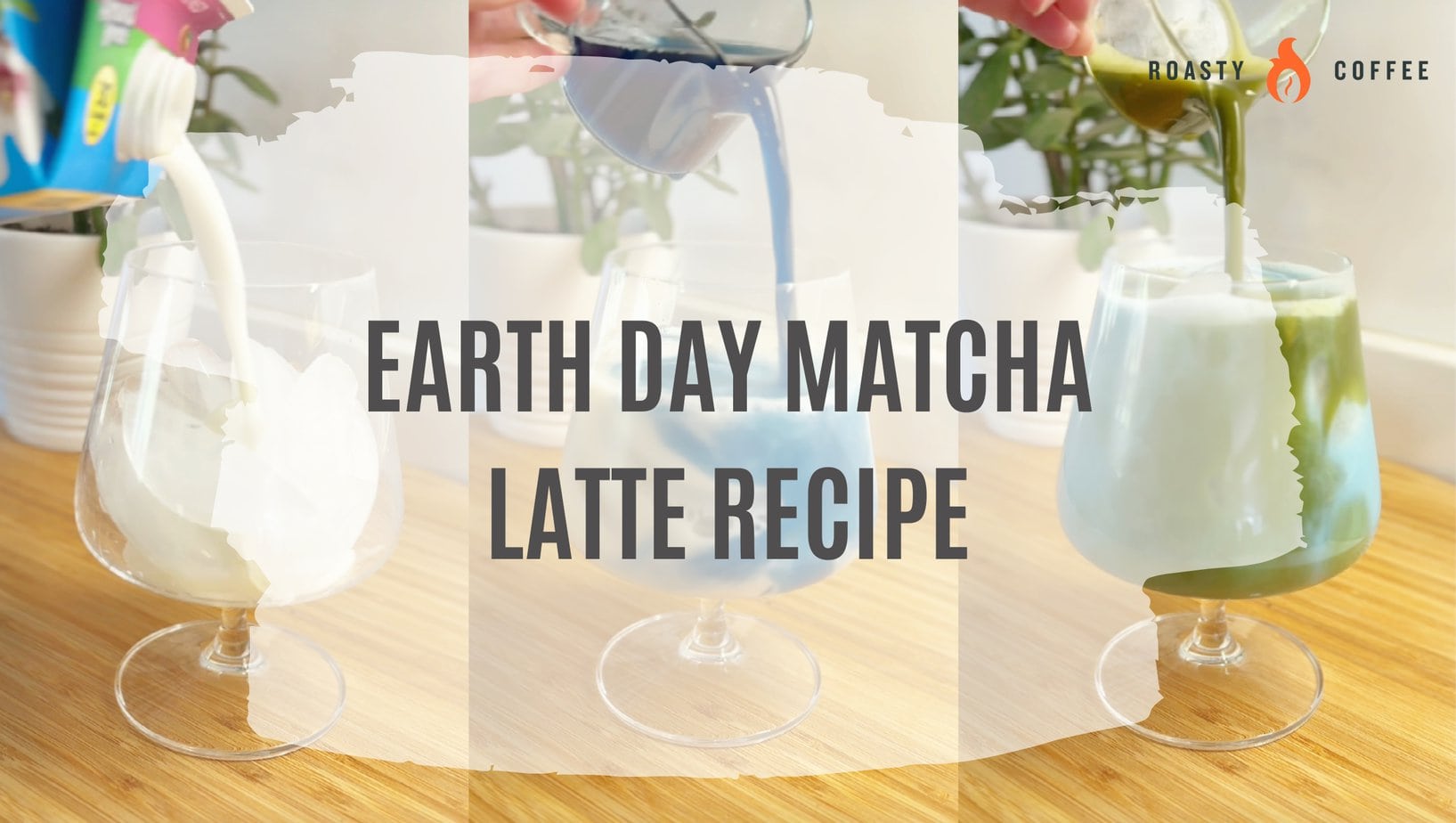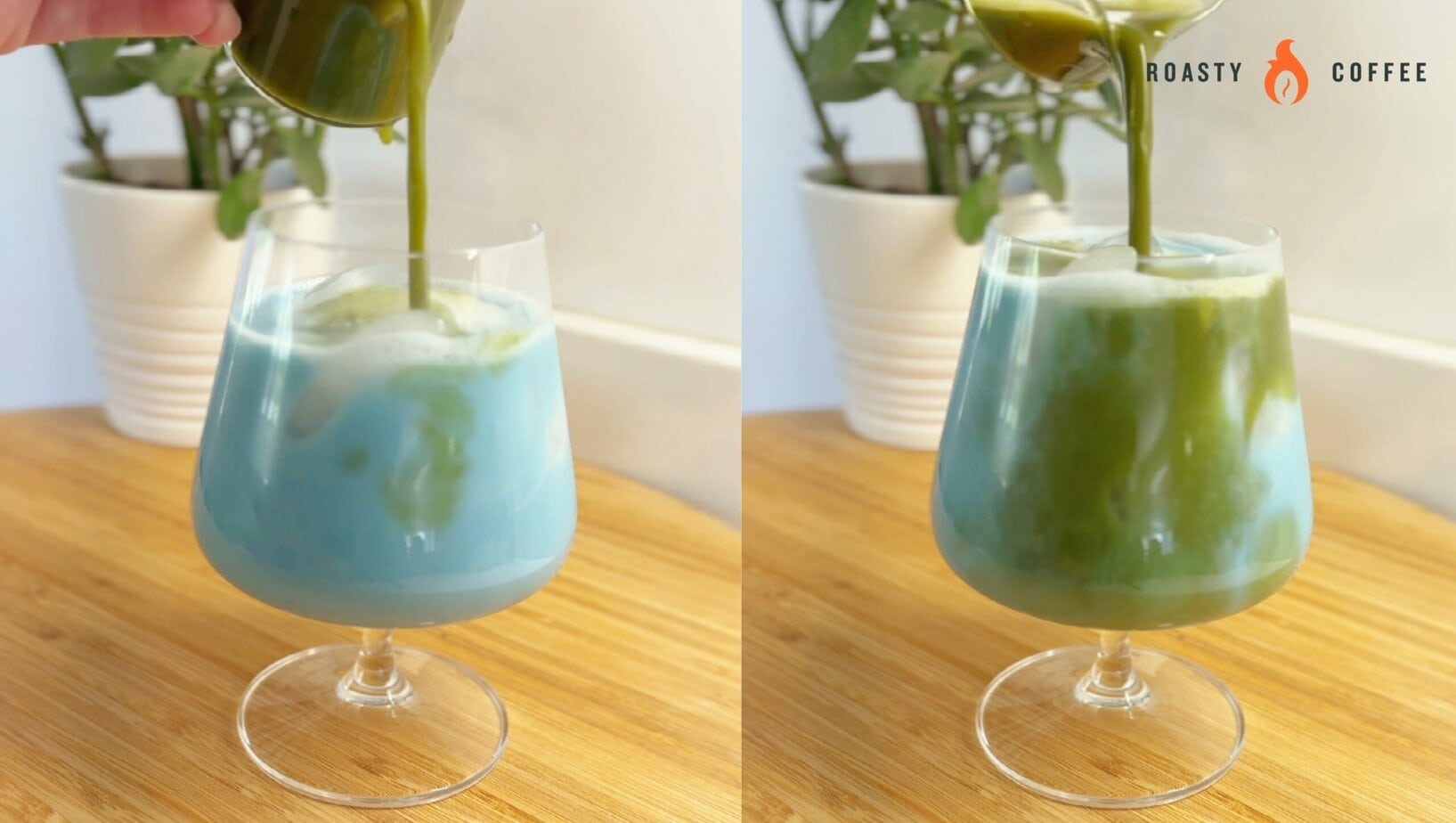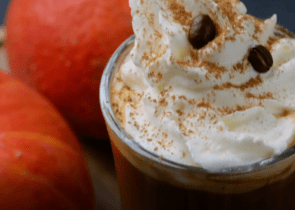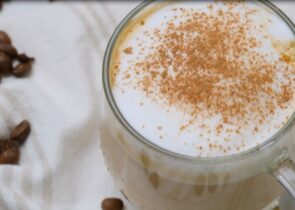Here at Roasty, we believe every day should be Earth Day. After all, this is our home — shouldn’t we always appreciate it? However, April 22 is the official calendar date for celebrating our planet and supporting environmental protection efforts.
This Earth Day, get out of the house and get involved by organizing a litter pickup in the neighborhood or local park, planting a tree, or creating a compost pile. Then, reward yourself with an icy and refreshing themed matcha latte. It’s perfect for sipping not just on Earth Day but every other spring day after, too.

What’s Earth Day Matcha?
The Earth Day matcha latte consists of a few ingredients: matcha green tea, butterfly pea flower tea, and milk of your choice, usually made foamy by a milk frother if you’re serving it cold or a steamer if your latte will be served hot.
The drink’s name comes from its one-of-a-kind appearance. When the bright blue- and green-colored teas swirl around in your cup with the milk, it looks a bit like Earth. The matcha represents land, the butterfly pea flower tea is the ocean, and the milk is the cloud cover.
So, when you make this tea latte, don’t forget to serve it in a clear cup and take a gorgeous photo of the colorful treat before you slurp it down.
Before sharing the recipe, let’s look more closely at the two types of tea involved.
What Is Matcha?
At this point, matcha green tea is probably no stranger to you, as the brightly-hued beverage has been trendy in the coffee and tea world for a few years now. But if you haven’t yet had the pleasure of meeting matcha, allow us to introduce you.
China-originated matcha powder comes from grinding high-grade, specially-grown green tea leaves. So, you can’t steep it in hot water as you would with loose-leaf tea. Instead, you whisk the powder into hot water until it forms a vibrant-colored, frothy mixture.
Matcha has a distinctive earthy taste and aroma, but those aren’t its only traits. It’s also packed with some rather impressive benefits, including:
- High antioxidant content. Matcha has plenty of compounds called catechins that act as natural antioxidants. These catechins stabilize harmful free radicals (compounds that damage cells or lead to chronic disease).
- Brain-boosting properties. According to Healthline, researchers found that several components of matcha can elevate brain function. The green tea made attention span, reaction time, and memory better. It also has L-theanine, which promotes alertness and prevents caffeine crashes — that’s extra good news since matcha contains caffeine.
- Cancer-fighting or preventing elements (at least, according to test tube and animal studies.) One of the catechins found in matcha is called epigallocatechin-3-gallate. But that’s a mouthful, so we’ll call it by its abbreviated name, EGCG. EGCG has anti-cancer properties and effectively kills prostate, skin, lung, and liver cancer cells. Researchers obtained this info via test tube and animal studies; we’re still not 100 percent sure how these results translate to humans.
- Heart health promotion. Some studies have shown that sipping green tea, like matcha, can lower the risk of heart disease and stroke. Of course, matcha isn’t some magical beverage guaranteeing heart health; anyone hoping to see results has to combine it with a well-rounded diet and healthy lifestyle.
What Is Butterfly Pea Flower?
Butterfly pea flower tea (a.k.a. blue tea) is a caffeine-free herbal tea made by steeping the Clitoria ternatea, or butterfly pea flower.
You’re most likely to find butterfly pea flowers and tea made from it in South East Asian countries, but in recent years, more non-natives have become exposed to the plant and beverage.
The butterfly pea flower’s most noticeable attribute is its breathtaking blue hue. But it’s more than just a pretty face. South East Asian communities have used the plant for its health benefits and beautifying properties for centuries.
So, why is this plant so valuable for Ayurvedic medicine? Because:
- It’s rich in ternatins. Ternatins are antioxidant compounds associated with inflammation alleviation and preventing cancerous cells’ growth. Additionally, butterfly pea flower plants contain other anti-inflammatory, antimicrobial, antiviral, and immune-boosting antioxidants.
- It gives the brain a boost. This plant has a reputation for boosting brain power and has been used to treat anxiety, depression, ADHD, and stress for years. Butterfly pea flower tea’s brain-boosting power is courtesy of the acetylcholine it contains; this compound is essential for brain health.
- It has beauty benefits. Everyone wants to feel beautiful, and butterfly pea flowers can help. The topical application of butterfly pea flower can increase skin hydration and treat itchiness, redness, or irritation. It can also aid in hair growth, thanks to its anthocyanin. Anthocyanin increases blood flow to the scalp, and increased blood flow strengthens hair follicles and encourages new hair growth.
Those are but a few of the butterfly pea flower’s benefits. We could go on, but we won’t. Instead, we’ll say this: this is one remarkable plant.
@roastycoffee Butterfly pea flower + matcha = heaven on earth #matchalatte #butterflypeaflower #lattelove #earthday #coffeetok ♬ original sound – soph
Make the Earth Day Matcha Latte at Home
You’ll Need
Note: You’ll notice we didn’t provide exact ingredient measurements. That was intentional. This drink is best when prepared according to your unique preferences, so add as much or as little of each ingredient as you’d like.
- ice cubes
- milk or creamer of your choice
- butterfly pea flower tea
- matcha tea
- honey or agave syrup
- vanilla extract or vanilla-flavored simple syrup (optional)
The Process
Step One
First, brew the butterfly pea flower tea. For best results, follow the instructions printed on the product’s label and be sure you’re steeping it in hot but not boiling water.
You may need to research to decide what product you’ll like best. As you dig deeper into brands, look into the different kinds of this tea, too. There are butterfly pea flower powder and loose-leaf options for you to choose from, so you’ll need to keep the pros and cons of each in mind as you search for something to buy.
Once you’ve brewed your tea, set it aside — we’ll come back to it in a moment, but there are other steps to make it through first.
Step Two
Next, pour ice and your favorite milk or creamer into a serving glass. We used almond milk, but it doesn’t matter — plant milk or plant milk-based creamers make a latte creamy just as well as dairy products. So, feel free to go either route.

Step Three
It’s matcha time! Prepare the tea according to the instructions printed on the product label. Then, if your sweet tooth demands, stir honey or agave syrup into the matcha. You can even add flavors here, too, like vanilla.

Step Four
Pour the butterfly pea flower and matcha shots over the milk and watch the colors swirl together. It almost looks too pretty to drink. But trust us — you’ll want to experience these flavors.

Frequently Asked Questions
What’s the Best Milk for a Matcha Latte?
You can pour whatever milk or non-dairy milk alternative you like into your matcha latte. However, we like mixing matcha with coconut or oat milk best.
Since oat milk doesn’t have a particularly overpowering taste, it lets matcha’s unique flavor profile shine while giving it a nice creamy texture. On the other hand, coconut milk is a little harder to find. However, like oat milk, the non-dairy milk alternative makes matcha lattes creamy, and its taste complements matcha’s well.
Is Matcha Stronger Than Coffee?
First, when we use the word “stronger” here, we’re talking about caffeine level, not flavor.
That said, matcha is not as strong as coffee. The average cup of joe contains between 100 and 140 milligrams of caffeine. Matcha provides a less intense energy boost in comparison, as it usually has around 70 milligrams of caffeine per eight-ounce cup.
However, the opposite is true if you’re talking about decaffeinated coffee. A cup of decaffeinated coffee usually has two to 15 grams of caffeine. So, compared to that, matcha green tea generates a more energizing buzz.
Is It OK To Drink Matcha Every Day?
Yes, you can have matcha daily. But, as with anything, consume it in moderation. Try not to have more than one or two cups per day to avoid potentially being affected by any of the green tea’s negative side effects.
Enjoy Your Latte!
If you’re desperate for a spin on the traditional matcha latte, this could be the drink you’re searching for. It tastes delicious, and that it’s so pretty is the icing on the cake!
Happy Coffee-Free Caffeinating!

Earth Day Matcha Latte Recipe
Earth Day Matcha Latte is a delicious and potentially eco-friendly beverage that can help celebrate and raise awareness for the importance of environmental sustainability.
Ingredients
- Ice cubes
- Milk or creamer of your choice
- Butterfly pea flower tea
- Matcha tea
- Honey or agave syrup
- Vanilla extract or vanilla-flavored simple syrup (optional)
Instructions
- Brew the butterfly pea flower tea.
- Pour ice and your favorite milk or creamer into a serving glass.
- Prepare the matcha according to the instructions printed on the product label.
- Pour the butterfly pea flower and matcha shots over the milk and enjoy.








